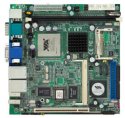Mini-ITX mobo uses newest Via chipset, supports Linux
Dec 17, 2004 — by Henry Kingman — from the LinuxDevices Archive — views Commell is shipping a mini-ITX board said to offer advanced graphics features, based on Via's latest northbridge. The LV-667 is available with a variety of video port options, and targets PVRs, set-top boxes, gaming machines, kiosks, POS (point-of-sales/service) devices, and more.
Commell is shipping a mini-ITX board said to offer advanced graphics features, based on Via's latest northbridge. The LV-667 is available with a variety of video port options, and targets PVRs, set-top boxes, gaming machines, kiosks, POS (point-of-sales/service) devices, and more.
(Click for larger view of Commell LV-667)
The LV-667 is available with a Via C3 or Via Eden CPU, which are currently available in speeds up to 1.3GHz and 1GHz, respectively. Both chips use the same core, but the Eden is tested and packaged for higher temperature operation in fanless, embedded environments.
The LV-667 uses Via's new CN400 northbridge, which is replacing the CLE266 on the newest mini-ITX boards from Via. The CN400 adds support for 200MHz front-side bus speeds, a 1GB/s “Ultra V-Link” southbridge interconnect, and hardware acceleration for MPEG-2 and -4, among other new features. The CN400's MPEG engine requires application awareness, and Via in August released a Linux build of the Xine media player for it.
The CN400 includes a graphics core from Via graphics chipset subsidiary S3. The “Graphics UniChrome Pro IGP” core supports all display types, from CRTs and LCD screens to standard definition TVs and HDTVs, Commell says, and the LV-667 is available with an optional DVI port, TV/HDTV port, or with an LVDS interface through a mini-AGP card.
To learn more about the CN400 and UniChrome Pro IGP, be sure to read our story about the Via Epia SP, the first Via mini-ITX board to use the chip. The chip is also used in Via's smaller nano-ITX board, and is slated for use in the dual-processor Epia DP, expected in early 2005.
The LV-667 supports up to 1GB of DDR400/333/266 SDRAM through a “FastStream64” memory controller theoretically capable of supporting up to 8GB.
The board uses Via's VT8237 southbridge, which supports a wide range of I/O interfaces, including SATA, although the LV-667 does not offer an SATA port.
The LV-667 includes the following I/O ports:
- Two UltraATA/100 IDE ports
- Two RS232C serial ports
- Three IEEE1394 (firewire) ports with Via VT6306 MAC/PHY
- Four USB 2.0 ports
- A DB15 VGA port
- PS/2 keyboard and mouse ports
- Programable 8-bit digital I/O interface
- One VIA VT6103 10/100Mbps PHY, and one Realtek 8100B 10/100Mbps PCI controller
- CompactFlash Type-II socket
- Winbond W83697UF watchdog timer
- One SlimPCI port
- One mini-AGP port
The LV-667 is well-supported under Linux, according to Commell.
This article was originally published on LinuxDevices.com and has been donated to the open source community by QuinStreet Inc. Please visit LinuxToday.com for up-to-date news and articles about Linux and open source.